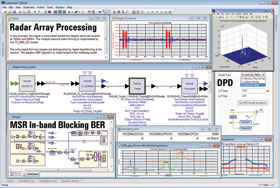

Agilent Technologies announced the newest release of SystemVue, its premier platform for designing communications and defence systems. SystemVue 2013.01 provides new application support for system-level architects, digital signal-processing modellers and test and measurement verifiers who are designing next-generation MIMO radar systems and wireless/4G infrastructure.
The new release enables users to make critical decisions about RF and DSP architecture more effectively by bringing real-world modelling, standards-based validation and links to high-performance test equipment into the R&D environment. Doing so reduces design iterations and project risk for emerging wireless and defence technologies, while allowing faster deployment.
SystemVue’s W1905 radar model library now offers sophisticated signal processing support for array-based radar technologies such as MIMO, phased-array and synthetic-aperture radars.
With the new release, radar architects can now evaluate array-based radar architectures using approximately 70 simulation reference blocks and 50 application examples. They can also use their own signal processing algorithms in a variety of modelling formats, including C++, math, FPGA/HDL and SystemC.
SystemVue also allows radar architects to account for a variety of other system-level effects to render realistic virtual scenarios that include:
* Real-world RF models (using X-parameters).
* Measured waveforms, to and from Agilent test equipment, including a free Waveform Sequence Composer utility that works with Agilent’s M8190A arbitrary waveform generator.
* Physical/inertial fading factors (such as Doppler shift, range delay and terrain-based clutter), from external modelling applications.
* Antenna directionality and spacing, interferers, jamming, targets, clutter, fading and other non-idealities.
To address the needs of the commercial wireless space, SystemVue 2013.01 enables system-level modelling of multi-standard radio (MSR) performance under 3GPP Release-9 TS 37, and digital pre-distortion (DPD) for high-volume power amplifiers in 4G/LTE and wireless LAN 802.11ac applications.
With new MSR simulation templates and expanded 2G/3G standards support, the W1916 3G baseband library now allows SystemVue to validate backward compliance of 4G/LTE equipment alongside legacy GSM, EDGE, WCDMA and interfering signals, both in-band and inter-band.
Moreover, many of these same base-station, femtocell, WLAN and handset designs employ a less expensive pre-distortion technique that improves RF system performance, without adding significant battery drain or complexity.
The updated W1716 DPD Builder provides modelling support for lookup tables, along with a sophisticated new crest-factor reduction algorithm.
For more information contact Andrew Hutton, RF Design, +27 (0)21 555 8400, [email protected], www.rfdesign.co.za
| Tel: | +27 21 555 8400 |
| Email: | [email protected] |
| www: | www.rfdesign.co.za |
| Articles: | More information and articles about RF Design |

© Technews Publishing (Pty) Ltd | All Rights Reserved